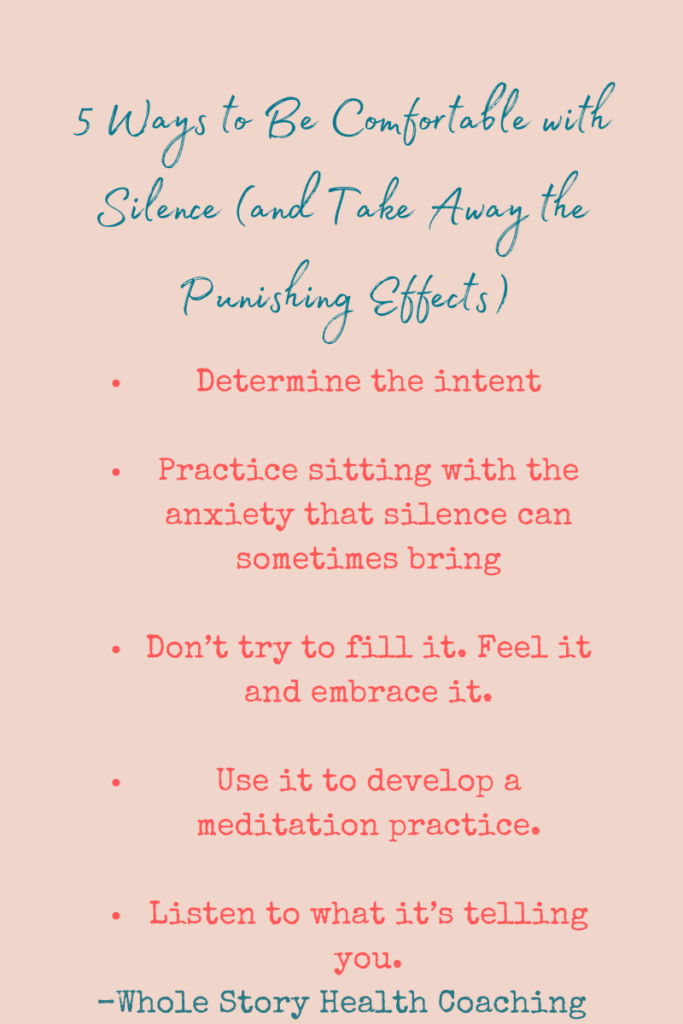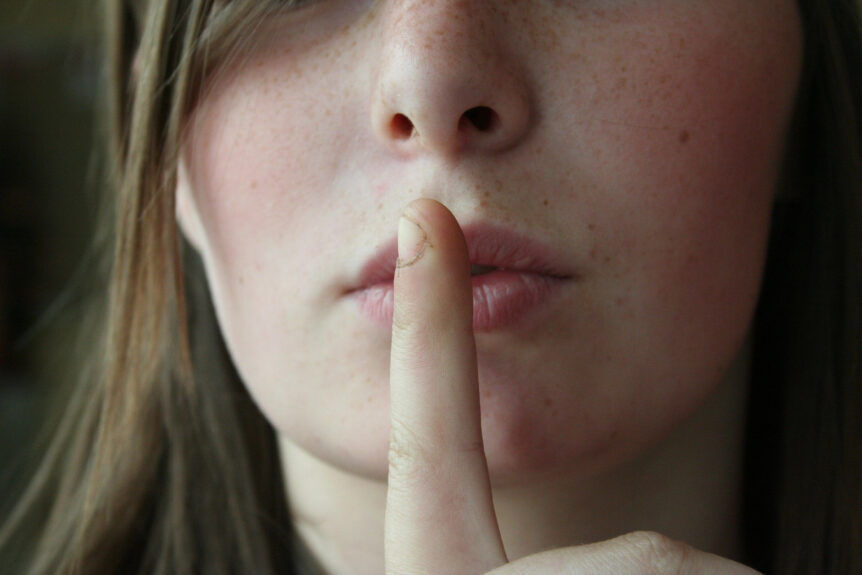Long before I ever welcomed silence into my life, a friend brought my struggle with (and against) it to my attention. I’m not sure that it was anything that I would have noticed on my own—other than I didn’t like it.
Although it was many years ago, his words still echo in my mind —“My grandfather taught me a long time ago to be comfortable with silence… to be safe and secure within my own thoughts…
His grandfather’s advice felt like an impossibility to me.
My Relationship with Silence
At the time, silence was one of the most uncomfortable experiences imaginable. Because I hadn’t dived too deeply into its roots, and didn’t understand the depths, I didn’t realize that I had attached some very negative meanings to its presence.
For instance, I subconsciously associated any periods of silence with loneliness. As a little girl, it was during long periods of quiet that I felt the most alone. Frighteningly alone. It caused such anxiety for me. I always felt restless, bored, powerless, and even disturbed by its disruption of my noisy, active world. I began to despise and fear silence.
The Scars of the Silent Treatment
Over the years, I noticed patterns in my relationships (and even some friendships) in which silence had been used as a weapon—or a method of passive aggressive communication, control, and/or manipulation. Those patterns only reinforced the loneliness perspective.
Since silence had become the voice of abandonment, rejection and disapproval, if someone was being silent, I believed that I had done something wrong.

It felt like punishment. My interpretation was that there was a refusal (of the acknowledgment of my existence). I felt insignificant.
At my worst, I would overthink what was happening (or what I thought was happening). It never took long for my anxiety to take over and send my thoughts and moods into a spiral.
Eventually, even short periods of silence became synonymous with being ignored, unwanted, and unseen. Without constant, immediate reponses, feelings of invisibility and worthlessness would begin to surface.
Often, people were legitimately preoccupied. But, without knowing the cause of their absence, I assumed that they had just disappeared…and it was my fault.
My painful interpretations, the (assigned) meanings that I had given to other’s unresponsiveness, and my “history with silence” all took a toll on friendships and relationships.
In an effort to spare myself any further pain or potential mistreatment, I would put up emotional walls to protect myself. As you can imagine, my own silence and distance only made things worse.
Whole story health coaching
Finding Sanity in the Silence
I used to try to fill the silence. Now, I try to feel the silence. For example, I have come to cherish and protect the “alone time” that I afford myself. I have learned to appreciate and enjoy the peace and calm of being alone with my thoughts.
Importantly, I have carefully cultivated my own bit of peaceful paradise. No longer intimidated by what type of thoughts may threaten my mood or stir up painful emotions, I am now able to welcome them and to listen eagerly to what they are telling me.
Sometimes, I am informed of an unhealed wound. Sometimes I am alerted of the need to shift my priorities and reframe my thinking. Many times, I get to experience a level of creativity that would be out of my reach, if I were otherwise occupied with grasping for the straws that lay outside of me.
Appreciating the gift of silence has embedded in me the recognition of its benefits, such as the calmness it brings during times of chaos; whether within me or outside of me.
Silent Self-Care
My new morning ritual begins with starting my day in silence. I get up, make my coffee, sit on the sofa and just breathe. Quietly waiting for the sun to come out is now an experience that I look forward to. I welcome the opportunity, as well as the peace it brings.
My quiet mornings and early afternoons have become a cherished (and necessary) part of my self-care routine. It’s a time that gives me the chance to tune out the noise of the world and tune in to my calm. Grounding myself at the beginning of my day allows me to establish a foundation on which to build.
The solitude incorporates my values of seeking inner peace and the nurturing of my spirit. It reinforces the boundaries that I so desperately needed to put in place for myself — boundaries that prevent me from being “dis- tracted” … from mentally and emotionally being pulled apart at the seams.
It has even become a part of my solution to overcoming people pleasing—I’d always had a tendency to respond with immediate availability to any request for my attention or time — no matter the inconvenience or the lack of reciprocity. The emotional drain that I began to experience took an incredible toll on me and my friendships.
My friend was right, being comfortable in the silence was a lesson worth learning.
5 Ways to Be Comfortable with Silence (and Take Away the Punishing Effects)
- Determine the intent.
Sometimes silence is just the other person taking a break to recharge. As an introvert, I require alone time and solitude to make sure that I stay mentally, emotionally, and spiritually healthy. My silence in those moments is about self-care… not punishment. However, when my ability to communicate in a healthy way was non-existent, I used silence as a way to express my anger or pain. Understanding the intent allows you to better gauge the health of the friendship, relationship or yourself.
- Practice sitting with the anxiety that silence can sometimes bring.
Silence can be anxiety-provoking…especially when we’re dealing with the unknown. Maybe a text is being ignored or an email response hasn’t come. Maybe the person seems to have disappeared or is refusing to speak.
Whatever the case, not knowing what to expect or when to expect it can send our thoughts and emotions on a rollercoaster ride.
Despite the emotional and physical discomfort, learning to sit with the anxiety will help us to develop this important aspect of coping with it.
Body scans and diaphragmatic breathing are also a great help. Not only do they keep us grounded in the present, but we gain valuable insight into our body’s cues and reactions. Lastly, journaling is another great way to keep track of your reactions and patterns.You may be surprised by what you find.
- Don’t try to fill it. Feel it and embrace it.
Too often, we try to distract ourselves instead of gaining a better understanding of our reactions. Rather than divert our attention, we can learn to embrace the silence and be present in the moment. Observing our thoughts, feeling our bodily sensations, and noticing our breathing can become a part of our self-care routine and learning to manage our reactions.
The other benefit is that it gives us control of the silence. We are no longer victims, once we are able to welcome it and enjoy the peace it can bring. We give ourselves the power of peace over punishment.
- Use it to become more mindful.
As I mentioned above, silence is a powerful opportunity to bring peace into what was once an anxious interpretation of the unknown. When we learn to regulate our emotions in healthy ways, we are better able to navigate life. Mindfulness gives us the chance to take our thoughts captive and notice how they are affecting us—in the flesh and spirit.
- Listen for what can be discerned.
“My grandfather taught me a long time ago to be comfortable with silence…”
Discerning what aligns with scripture and what is exalting itself against it becomes easier when we learn to listen, instead of distracting ourselves.
This requires us to be able to sit with our thoughts, even welcoming those that may be uncomfortable. If we allow it, silence can be one of our greatest teachers.

What is your relationship with silence? Let me know in the comments.
Follow me on…



